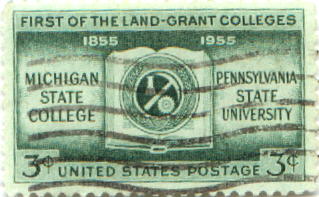An uncertain Economy 1820-1860
 In the 1820s, America's population was still moving ever westward
in search of opportunities and advancement. These people are
sometimes depicted as being fiercely independent and strongly
opposed to any kind of government control or interference. But in
fact they received a lot of government help, directly and
indirectly. Government-created national roads, such as the
Cumberland Pike (1818) and the Erie Canal (1825), helped move
farm produce to market. The federal government set up numerous
land-grant colleges to train young people in agriculture, as well
as agricultural experiment stations and an array of service
agencies, all designed to further the education and welfare of
the independent farmer.
In the 1820s, America's population was still moving ever westward
in search of opportunities and advancement. These people are
sometimes depicted as being fiercely independent and strongly
opposed to any kind of government control or interference. But in
fact they received a lot of government help, directly and
indirectly. Government-created national roads, such as the
Cumberland Pike (1818) and the Erie Canal (1825), helped move
farm produce to market. The federal government set up numerous
land-grant colleges to train young people in agriculture, as well
as agricultural experiment stations and an array of service
agencies, all designed to further the education and welfare of
the independent farmer.
Americans of this era shared a common desire to better themselves through economic participation. People who held differing opinions about how to achieve the same ends fought many of the political and economic struggles of the 19th century. The results of those struggles underscore the importance of both individualism and a degree of government involvement.
When Andrew Jackson became president in 1829, many who were poor or newly rich idealized him as an individualist in their own likeness because he had started life in a log cabin in frontier territory. President Jackson opposed the new Federal Bank of the United States, chartered in 1816; he believed it favored the entrenched interests of the East against the West. When he was reelected for a second term, Jackson opposed renewing the Bank's charter, which was due to expire in 1836. Congress supported him in 1833, effectively killing the second National Bank. Jackson preferred putting the U.S. government's deposits in the state banks controlled by his political allies.
Jackson's actions helped precipitate the sharp business panics that occurred in 1834 and 1837. The East, particularly the industrial sector, suffered from an eventually crippling tight money supply; meanwhile, in the West, federal deposits in state banks made money more plentiful in rural areas and contributed to land speculation and price inflation. The same plot of land was often sold several times, each time at a profit; U.S. Treasury income from the sale of land rose from $5 million a year in 1834 to $20 million a year in 1836. But inherent in this boom were the seeds of economic disaster.
The first signs came in 1835 when crop failures made it necessary to import wheat from Europe. Some importers were frightened by the economic depression and refused to extend credit to customers. In 1836, when the amount of money in circulation was already low, the Treasury issued an order that henceforth land purchased from the government had to be paid for in gold or silver. But these precious metals were in short supply, having been sent abroad to pay for imports. Confidence in the nation's financial system was shaken, even shattered, and Western banks began to close.
During this time, English traders could not collect on their sales in America, and many of them went bankrupt. Cotton mills closed in England, and American planters saw their markets disappear. By the summer of 1837, business was paralyzed, and it was not until the early 1840s that a semblance of confidence in business was restored.
But periodic economic dislocations, such as "The Panic of 1837," did not curtail rapid U.S. economic growth during the 19th century. Presidents elected after Jackson also came from the West, or were allied to those who reflected rural sentiments, and they shared Jackson's mistrust of central power.
